Nile Rodgers: “Bernard Edwards hated my sound with a big fat jazzy guitar… he talked me into buying a Strat!”
The godfather of funk guitar talks his enormous collection, growing up in New York's studio session scene and how Fender's Acoustasonic Stratocaster is stoking his creative fire
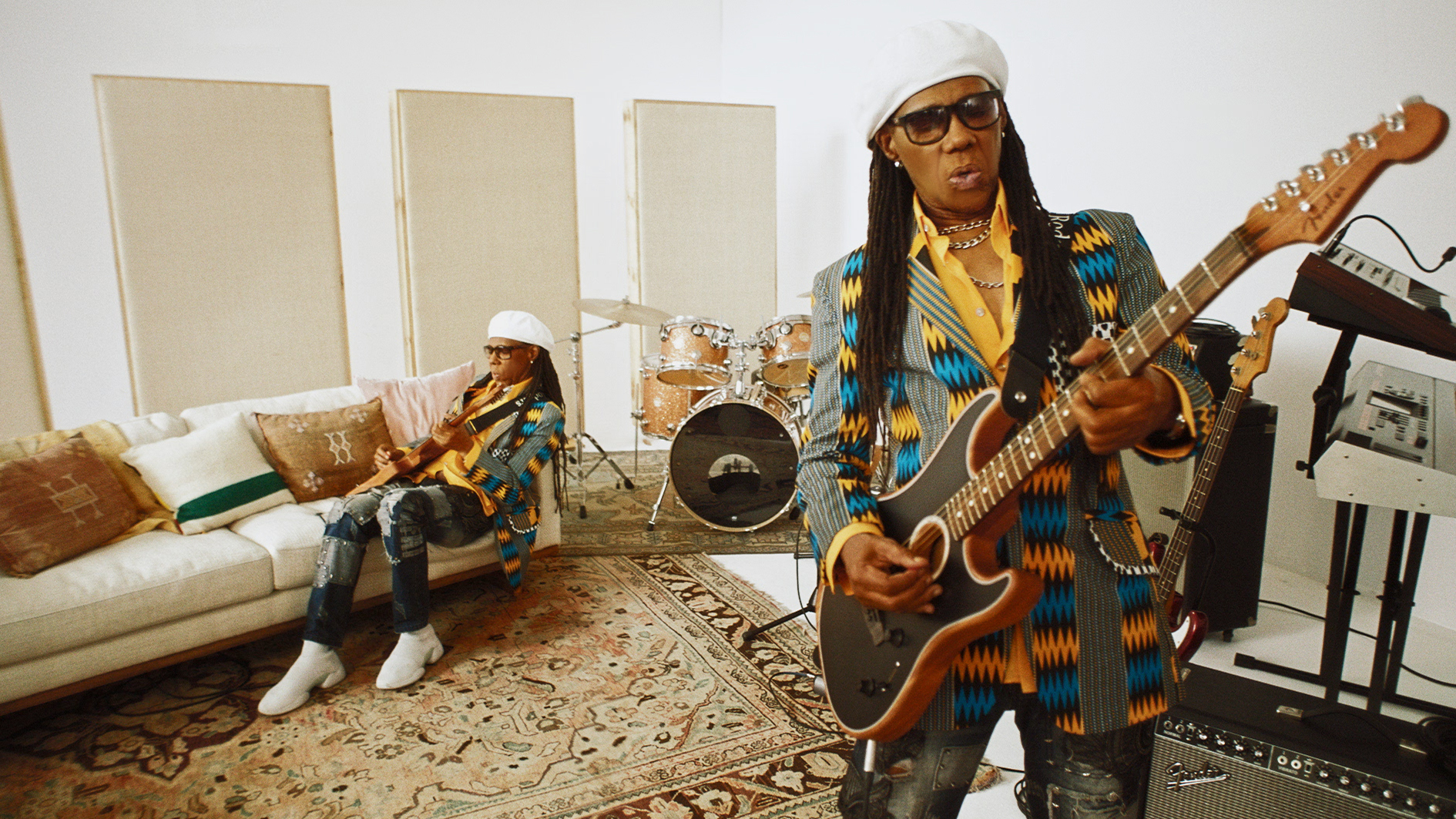
“I had so much fun, man!” grins Nile Rodgers, speaking to Guitar World about the new promotional video he recorded for the Fender Acoustasonic campaign.
In the footage he can be seen orchestrating an entire song, with different electric and acoustic sounds or blends thereof, with just one single Strat-shaped instrument. If the Big F were looking to emphasize the versatility of their new modern hybrid, they certainly went to the right musician…
His work in Chic cemented his stature as the godfather of funk guitar, but of course Nile Rodgers has been known for plenty more besides that – a songwriter, producer and arranger with endless collaborations over the decades, from the big hits with David Bowie, Sister Sledge and Madonna or more guitar-based ventures with Jeff Beck and The Vaughan Brothers to more recent success with artists like Christina Aguilera and Daft Punk...
“I hope people are able to understand it’s the guitar that’s doing a lot of cool stuff and not just me using different techniques,” continues Rodgers, about his involvement in the campaign.
“It still sounds like music, not just a demo video... or at least I hope! You guys are guitar players, maybe you can tell me! Hopefully it doesn’t sound too silly, like I’m going too far with stuff.
“Once I got the spiritual schematic of what the guitar was supposed to do, I started to compose the parts so that they would perform optimally for a certain setting. So when I do the opening, that’s me trying to convey the perfect setting for harmonics.
“And I use different types, the regular touch harmonic so you get the response on the fifth, seventh or twelfth fret and then also the pinched stuff, where you wind up going up an octave!”
Get The Pick Newsletter
All the latest guitar news, interviews, lessons, reviews, deals and more, direct to your inbox!
The new composition, co-written with Philippe Saisse, was titled Inside The Box as a result of the collaboration being born in lockdown, at a time when strict local and international regulations on travel and working in close proximity have severely disrupted sessions in their classic sense.
Rodgers explains his latest piece was originally conceived as a “CTI jazz kind of tune” for which he ended up finding the main melody already within the chords he was playing, while elsewhere utilizing a Talk Box for parts he’d normally save for wah.
But the main star of the show, naturally, was the instrument in his hands – arguably one of the most daring innovations in Fender history...
I was seduced by all the things this guitar could do in different positions, and I wanted to take advantage of that
“I was seduced by all the things this guitar could do in different positions,” confesses the 68 year-old New York veteran. “And I wanted to take advantage of that. So I redid some of the stuff and it worked even better. We were able to chart out the music, but also where I switch settings and what exactly I’m doing for each part.
“Then we sent it to Fender, explaining how I was blending all the voices. When we got on set, which was a very proud moment for me, they asked me to play what we’d done live. My assistant would tell me exactly how I’d dialed in each part and it sounded exactly like it on the recordings. I knew we had our shit down!”
You’ve played all types of guitars, but your connection to the Strat – most notably The Hitmaker – cannot be overstated. How many do you own in total?
“I would say maybe 25 or 30, maybe more. But you just said Strats, right?! [laughs] I’ve also got D’Angelicos, Les Pauls and others, so around 200 guitars in total. The Hitmaker is the one I’m most associated of course, and I play it every day. If you’re talking about the guitars that made the records, that always comes first and I’ve pretty played it on everything.
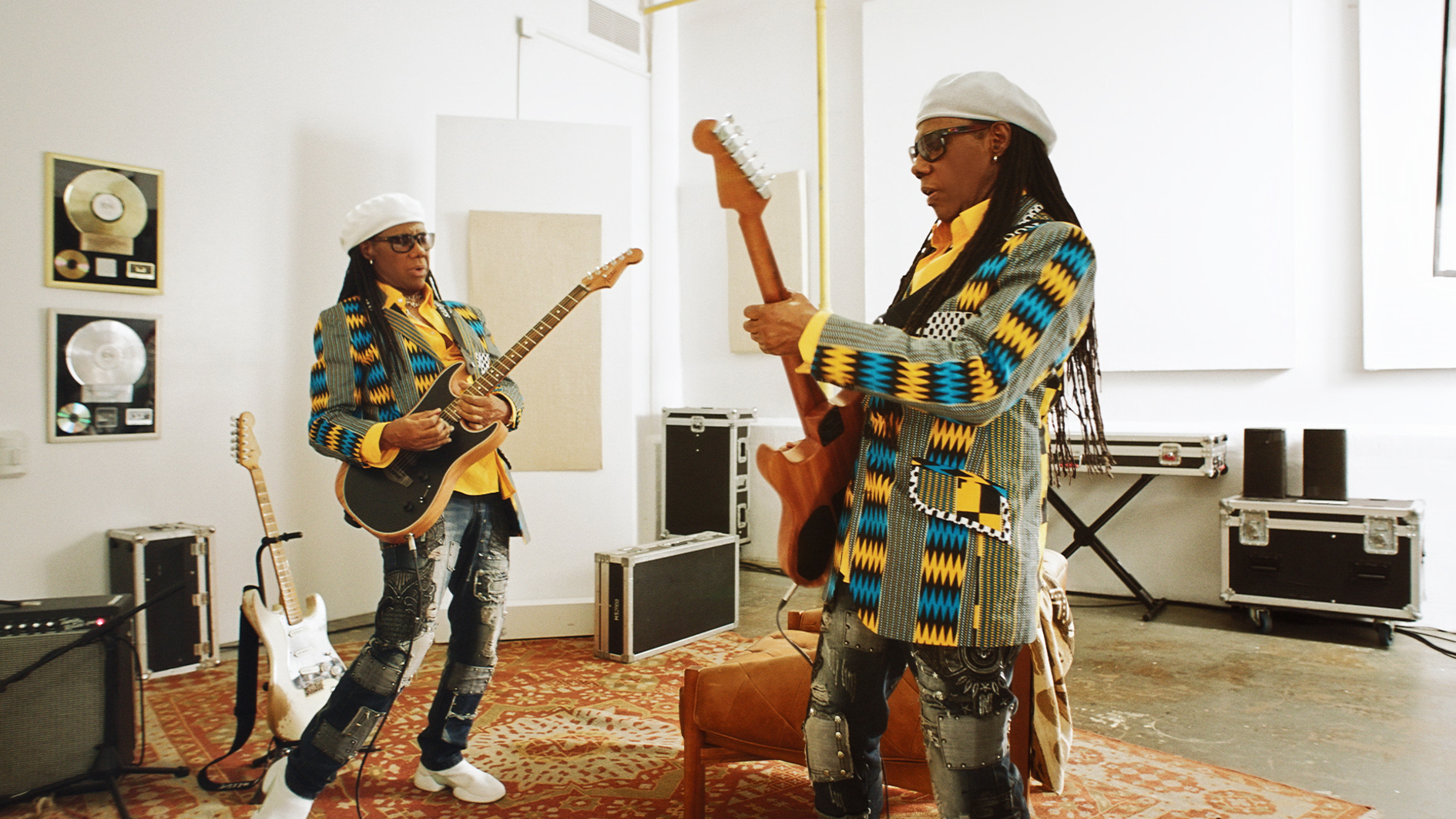
“Then when I was doing The Vaughan Brothers, I went out and bought a guitar a few months before we started. There was a famous guitar store in New York called Manny’s and I’d bought a lot of Strats there, so was pretty tight with them.
“They were looking through their inventory and found an old box labeled ‘Black Strat Gold-Plated’. They were perplexed. So they opened it up and it was brand-new but still 20 years old, they didn’t know it was there. And that guitar ended up on a lot of the Vaughan Brothers record…
“Stevie played my guitar and he loved the way it sounded. Of course, everyone thinks of his Strat with the SRV initials on it, but big parts of that album were on my black Strat with the gold-plated hardware. I might actually send that to Fender and have them come up with the story of how it was made and why it was made that year… because it was not a normal kind of Strat. That’s probably in third place.”
And as for second place?
“That would be a Mexican Strat I got around the same time, when I met Jimmie Vaughan. He actually said to me, ‘Just think about this, who knows more about guitar than Mexicans?!’ And I said, ‘You’ve got a point there, Jimmie!’
We bought a bunch of Mexican Strats and they were amazing. I loved how they felt, because I have small hands… that’s why The Hitmaker’s awesome, because it’s tiny!
“So we bought a bunch of Mexican Strats and they were amazing. I loved how they felt, because I have small hands… that’s why The Hitmaker’s awesome, because it’s tiny!
“The Mexican models seemed to have a smaller neck and the radius was just perfect. So I used one of those as a secondary guitar on a ton of recordings. Those are my three main Strats.
“For acoustic stuff, I use a Martin now and then but I tend to use jazz guitars more. I also have a number of pretty mega Les Pauls that I’ve played when doing recordings with Slash and Lisa Zappa.
“For a while I had two custom-made Guitar Man guitars, two of which were plexiglass so I used them mainly live for Chic gigs. When I finally did the Daft Punk record, they were like, ‘Dude, can you bring that see-through Strat!’ So it doubled The Hitmaker on Get Lucky.
“There are three guitar tracks, two of which were The Hitmaker and one of which was the plexiglass...”
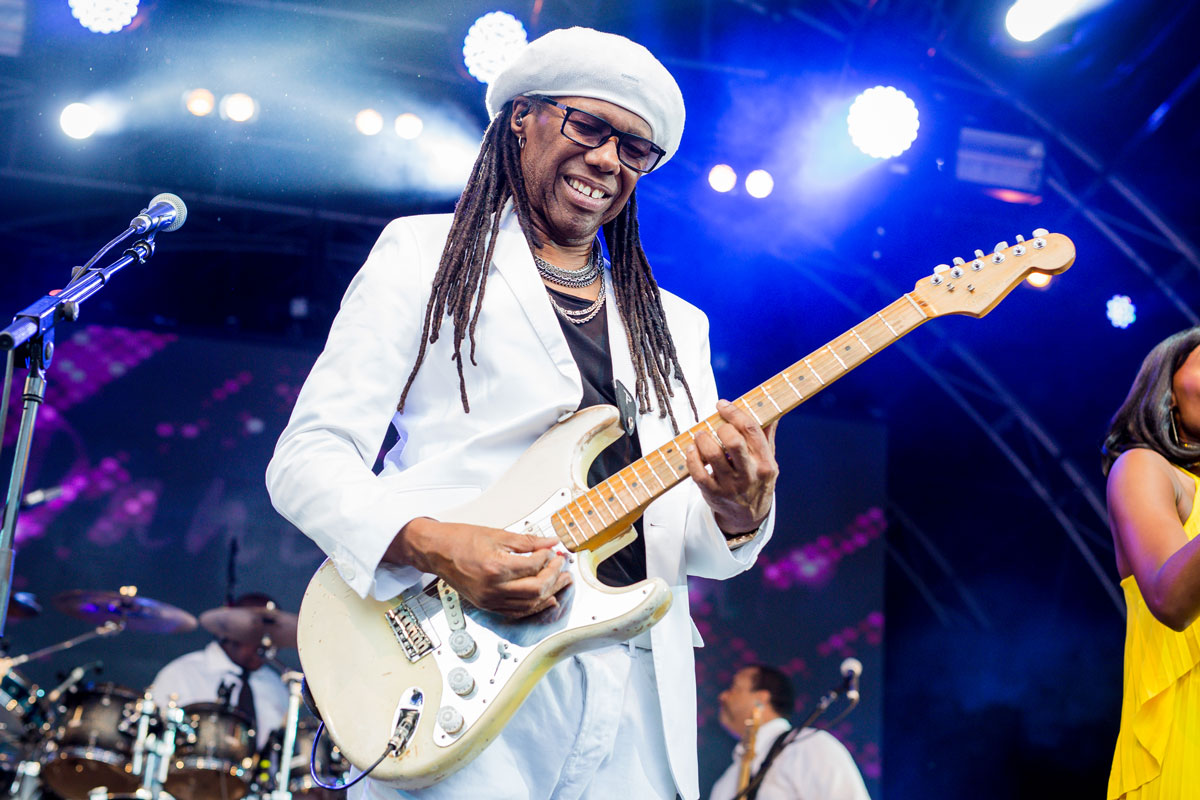
Speaking of which, it’s interesting how many parts are playing different variations of the same line. Would you say it’s one of the hallmarks of your playing?
“Yeah, embellishing chords and ideas is the essence of my thing. There’s a funny video, I think it’s still online, where Daft Punk were playing Get Lucky for the first time and they asked me to play along. You see me stop right in the middle and someone screamed out, ‘Man, it’s just four chords!’ And I’m looking at that person going, ‘So that’s what you hear, huh? Just four chords?!’
“I was trying to figure out the pattern. Yeah, I know it’s basically four chords, but there’s a pattern that I was trying to lock into so that it really was Get Lucky, not just somebody butchering it. I wanted to play it properly! So I was listening and listening and then I heard it! I never play a song the way I write it. I write it and then I have fun playing it.
“Even Let’s Dance, I originally came up with the concept and had a minor 13th as one of the chords, but then I moved it up an octave. And half the reason I can’t play along with my records is because when I did the actual recordings, I was still having fun inverting and interpreting the song. I actually have to write it all out, otherwise I won’t remember.”
The big riff in Give Life Back To Music, the opening track from Daft Punk’s last masterpiece, is another one that comes to mind...
“Exactly. That’s a cornerstone of my playing. Like with Get Lucky, it might seem like four chords but there are little lines hidden in there. One of the layers might be the simple chords, another will be dancing around. I need to hear the pattern of the dance before I can actually play it.”
You’ve used Fender amps a lot over the years. What else do you feel is essential to your tone?
“I’m quite simple, my pedalboard only has three things on it – a chorus, a wah and maybe an overdrive, which I don’t really use. Oh course, and there’s delay for Let’s Dance and a tuner.
“One thing I’ve been using lately a lot is my wah – I’ve always loved them, but I got this new one that is just as sweet as maple sweet and beautiful. The resonance quality when you are fully down is usually somewhere you go to and then come right back off.
“But on this pedal, you can go there and it actually has a bright, pingy quality that was desirable.
“I actually just played a song on Idina Menzel’s new album demo just the other day and it really added its own thing. I still might change it for the final recordings though!
I’m quite simple, my pedalboard only has three things on it – a chorus, a wah and maybe an overdrive, which I don’t really use
“I don’t know if it’s right to say which one as I’m mainly talking about Fender stuff right now, but this wah is killer. I gave one to Eric Clapton when we did the tribute to Ginger Baker. I was taking a solo during a classic Cream song, maybe White Room, and having so much fun, standing on it and jumping around.
“Eric looked at me and thought, ‘This guy is having the time of his life!’ It sounded so sweet with The Hitmaker. We were in London at Abbey Road, I had my gear and my tech crew, so it all felt perfect.”
What was it about the sound of a Strat that converted you?
“I was basically a jazz and classical player to begin with. The speed I could achieve using my fingers, I couldn’t achieve with a pick. I found it easier with hands. At the time, my musical partner was Bernard Edwards, who is a really funk-oriented guy and he hated my sound with the big fat jazzy guitar.
“He’d say it fed back too much and therefore you couldn’t play it loud, et cetera. We just had a hit record, so there was an opening act on our tour and I let their guitarist use my equipment. He was playing a Strat and was really chugging on it.
“That’s when I realized what Bernard was trying to get me to do – he talked me into buying a Strat, so I did. And that was The Hitmaker, bought in 1973 from a little pawn shop in Florida.”
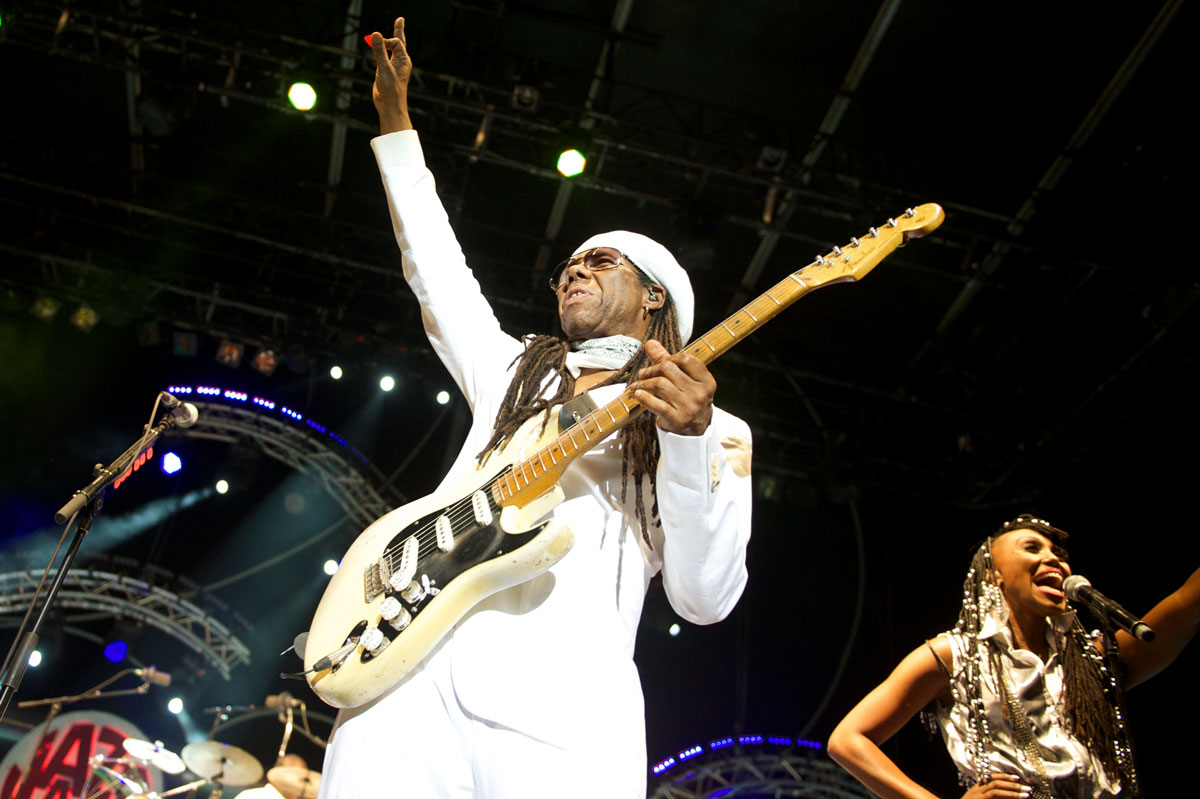
What do you look for when buying a guitar – how do you initially assess the instruments that might make it into your collection?
“I pick it up, hold it and check the weight. After Fender sent me a new Hitmaker, I said, ‘This feels really great but can you make it lighter?!’ Because I’m so used to mine being as light as a feather. That’s half the reason I love the Acoustasonic, it weighs nothing!
“I like the lighter guitars, that’s always been a thing with me – I guess because I grew up with jazz guitars which don’t weigh much.
“Typically what I do is hold it and then play it without an amp. If it sounds good without an amp, I know when I plug it in, that thing is going to smoke. Every Strat I own you would love, they all sound great even before you plug them in. I’ve decided to sell pretty much everything, I never set up a museum so they’re just sitting in the closet somewhere not being played and I feel guilty.
Now I have the Acoustasonic, I’m thinking, ‘Damn, I don’t even need my jazz guitars anymore!
“And now I have the Acoustasonic, I’m thinking, ‘Damn, I don’t even need my jazz guitars anymore!’”
And as for all the session work, what do you think is the biggest secret to your success?
“I guess it ties in with what Bernard was saying around that time – he felt that with my harmonic knowledge, I could be really special and unique in funk. Using all the theory and harmony, plus my learnings from the George Van Eps method, I could play over any chord or style of chord that’s written on a chart with just three notes.
“Anyone can when they know the thing that the producer or conductor wants to hear.
“That’s what I loved about the George Van Eps technique – it helped me understand what to do when on a session and seeing charts with very complicated voicings written out – because they’d been composed on piano. So what does a guitar player do… we only have six strings!”
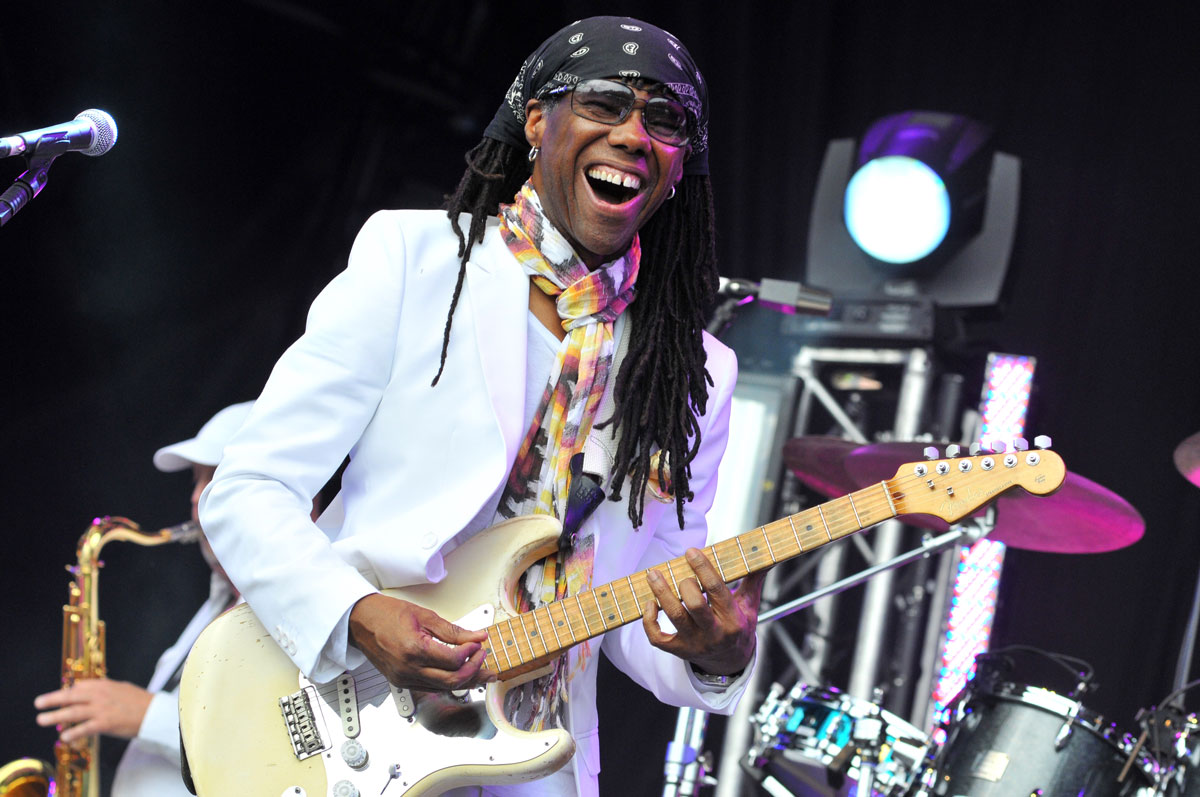
So a lot of it comes down to your spontaneity in the studio or in the moment...
“You have to instantly figure out what are the main voices that this composer wants to hear and you have to be able to play them right there on the spot. They might say, ‘My man, are you looking at the chart? That’s an A13 with a flat nine and a flat five!’
“And you have to figure out what will convince them and sound good enough… would it be a 3rd, 5th and flat 9?
“Right there in the session, you have to satisfy everyone in there and straight away. That’s what put me in the music business as a kid, I could go to a session and know whatever they had written out, I could play enough to make everyone happy.
“I remember my first session was with two mega guitar players – Cornell Dupree and Jeff Mironov...”
That must have been pretty nerve-wracking for you at the time!
Harold Wheeler said to me, ‘Yo, young blood, what’s that bullshit you’re playing there?!’ And I just said, ‘I’m just playing the bullshit you’ve written out on this chart!’
“Sure, I was the 20 year-old unknown guy. But because of my classical background, I’d done a lot of practice. It was for Luther Vandross and the arranger/conductor was great – Harold Wheeler, who is super famous now and does loads of stuff like the Academy Awards.
“But I was the little snotty-nosed kid in the group and he was hearing notes that weren’t written out on the chart, so he said, ‘Yo, young blood, what’s that bullshit you’re playing there?!’
“I was trying to be respectful and looked to him as the maestro, but I couldn’t help it – I just said, without thinking, ‘I’m just playing the bullshit you’ve written out on this chart!’
“Everyone on the session, including guys like the Brecker Brothers, laughed thinking, ‘How is he talking to Harold Wheeler like that?!’ Honestly, I wasn’t trying to be a smartass.
“But that got me into the New York studio musician scene and the rest was history! It was the first big session I played on and after that everybody started calling me to play on records.”
Amit has been writing for titles like Total Guitar, MusicRadar and Guitar World for over a decade and counts Richie Kotzen, Guthrie Govan and Jeff Beck among his primary influences as a guitar player. He's worked for magazines like Kerrang!, Metal Hammer, Classic Rock, Prog, Record Collector, Planet Rock, Rhythm and Bass Player, as well as newspapers like Metro and The Independent, interviewing everyone from Ozzy Osbourne and Lemmy to Slash and Jimmy Page, and once even traded solos with a member of Slayer on a track released internationally. As a session guitarist, he's played alongside members of Judas Priest and Uriah Heep in London ensemble Metalworks, as well as handled lead guitars for legends like Glen Matlock (Sex Pistols, The Faces) and Stu Hamm (Steve Vai, Joe Satriani, G3).
“I just learned them from the records. I don’t read tabs or anything, I don’t read music – I learned by ear”: How a teenage Muireann Bradley put a cover of Blind Blake’s Police Dog Blues on YouTube and became a standard bearer for country blues
“The Strat was about as ‘out’ as you could get. If you didn’t have a Floyd Rose, it was like, ‘what are you doing?’”: In the eye of the Superstrat hurricane, Yngwie Malmsteen stayed true to the original











